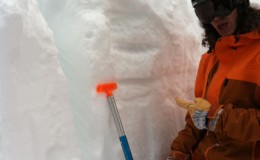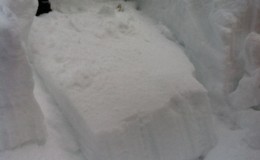Mountain Weather December 30, 2014
Date: 12/30/2014
Light snow and cold temperatures will continue today. A broad low-pressure trough is elongated across the southwest states, with an arctic airmass over Colorado. Winds remain mercifully light as the jet stream stays to our south. The arctic airmass moves east on Wednesday issuing out the cold temperatures. A closed low will begin moving across Arizona and New Mexico over the next few days, rotating moisture into southwestern Colorado under a South to Southeast flow. This pattern tends to be unfavorable for our mountains, but lets hope we see more than a few inches stack up by the end of New Year’s Day.
Today
High Temperature: 10
Wind Speed: 5-15 mph
Wind Direction: SE
Sky Cover: Mostly Cloudy
Snow: 1-3″
Tonight
Low Temperature: 0
Wind Speed: 5-15 mph
Wind Direction: SE, S
Sky Cover: Mostly Cloudy
Snow: 0-2″
Tomorrow
High Temperature: 18
Wind Speed: 5-15 mph
Wind Direction: SE
Sky Cover: Mostly Cloudy
Snow: 0-1″
Red Lady
Name: Travis Colbert
Title: Red Lady
Location: Kebler Pass Area
Date of Observation: 12/29/2014
Aspect: South East
Elevation: 12,300
Avalanches: The final (and steepest) rollover prior to the lap track released a very small slab (4-5 inches deep, 10 feet wide, ran about 20 feet).
Weather: Intermittent light snow; light but steady winds from the west. Partial clearing at times, then socked in again. Cold (8-10 degrees).
Snowpack: Snowpack was solid despite some wind transported snow in the bowl. Very soft, 2-inch unconsolidated wind slab in the bowl. Broke off a small section of the cornice with no results. Ski cut broke up the soft surface slab, but produced no significant results. All of the tracks from weekend were completely covered by the new snow and wind transported, recycled powder. Bowl skied perfectly; creamy soft powder turns all the way down. Went up for a second lap, but visibility dropped considerably at the summit. Skied fluffy powder through the glades all the way down to the road.
Uploads:
Crested Butte Area
Very Large Natural Avalanche off of Mt. Owen’s East Face
CBAC forecasters Zach Guy and Evan Ross investigate the crown of a slab avalanche that occurred around 12/22/14, and demonstrate the current persistent slab problem.
Crested Butte Zone
Name: Donny, Will
Date: 2014-12-28
Activity: Level One Avy Course, Tour Day
Location: Red Coon Glades
Elevation: 9200′ – 11,600′
Aspect: S – SE
Weather: Overcast to obscured skies, snowfall throughout day, periods of S2, but less than 5cm accumulation throughout day. Snow was mostly DFs with a short period of graupel. Light wind most of the day, with moderate W/SW winds above 11,000′. -13ºC at 9200′ @ 10:30; -18ºC at 11,600′ @ 13:00
Snowpack & Avalanche Obs: Not much new to report. Dec. 13th interface still present above 10,000′. More solar aspects present a harder crust, shaded aspects are more faceted. Nothing new here. Top 3cm of new snow was denser than bottom 2-3 cm due to increased winds. No signs of avalanches or instabilities.
Crested Butte Area
Name: Will Dujardin
Location: Snodgrass Weather Station Pits 12-28-14
Date of Observation: 12/28/2014
Aspect: North East
Elevation: 11120
Weather: Light snow and low clouds, very light wind.
Snowpack: We dug two pits just approx. 3.5 feet deep to the ground right next to each other on slightly different slopes (30 degrees and 37 degrees) on the NE aspect just below the weather station. We isolated two blocks to test the storm snow and the persistent slab in both pits. The 18~” of storm snow sluffed away in both pits to shovel taps. The 30 degree pit we were able to get the isolated persistent slab to go with applied boot pressure, in the 37 degree pit we had the storm slab (just above the top of the shovel in photo 1) go with a single skicut to the back, like a Rutschblock test of sorts, and the persistent slab to go with a boot kick in the same spot. See attached photos to see what the ski cut did in the 37 degree pit. It seems like it’s definitely harder, but not that hard, to trigger that persistent slab, and the slab formed from the recent storms is very touchy, it could definitely knock you down or bury you in a terrain trap, and if it stepped down to the persistent slab it would result in a massive avalanche . We skied back the low angle E-SE aspects to avoid the NE avalanche problem. Sorry for the lack of technical terminology!
Uploads:
Mountain Weather December 29, 2014
Date: 12/29/2014
A winter weather advisory was issued for our area. Last night we received light snowfall and are anticipating the snowfall to increase today. Northwest and southwest winds are converging along with a cold front and creating a band heavier snowfall in northern Colorado. This band will continue moving south today but the big question is weather all these things line up over the Elk Mountains as this system move south. If so, we’ll see the higher end of snow forecast numbers and if not, we’ll see continued light snowfall. The western portion of our zone should do ok either way with favorable orographics. We’ll see lingering snowfall on Tuesday as this weather system splits off to the south and shows some love for the San Juan Mountains. Wednesday will be drier with more weather anticipated on Thursday.
Today
High Temperature: 10
Wind Speed: 5-15 G20
Wind Direction: SW, W
Sky Cover: Overcast
Snow: 4-8
Tonight
Low Temperature: -5
Wind Speed: 5-15
Wind Direction: SW, W
Sky Cover: Overcast
Snow: 2-4
Tomorrow
High Temperature: 10
Wind Speed: 5-15 G20
Wind Direction: S
Sky Cover: Overcast
Snow: 0-2
What are facets?
 |
| Courtesy Photo |
 |
| This is a photo of a shallow slab that propagated impressive distances on the December 13th facet layer, near Purple Palace. Photo credit: Aaron Huckstep |
Ian’s Weather Resources
Current Data
Surface:
http://weather.rap.ucar.edu/surface/
https://avalanche.state.co.us/obs_stns/stns.php
http://mesowest.utah.edu/cgi-bin/droman/mesomap.cgi?state=CO&rawsflag=3
Schofield SNOTEL: http://www.wcc.nrcs.usda.gov/nwcc/site?sitenum=737
Upper-air soundings:
http://weather.rap.ucar.edu/upper/
Radar & Satellite:
http://www.weathertap.com ($84/yr, great mobile website as well)
Discussions
NWS: http://www.nws.noaa.gov/view/prodsByState.php?state=CO&prodtype=discussion
OpenSnow: http://opensnow.com/dailysnow/colorado
CAIC: http://avalanche.state.co.us/forecasts/weather/zone-forecast/
http://wasatchweatherweenies.blogspot.com
Forecast Models: Twisterdata.com
Top Center
NAM = 84hr 12km resolution
GFS = 384hr 27km resolution
RAP = 18hr 13km resolution
Left Side
700mb = orographic wind direction
500mb = vorticity
300mb = jet stream
Upper Right
Clickable map = one forecast image
Animated loop = all forecast images
Compare models = toggle between each model
dProg/dt = see the trend in the forecasts
Forecast Models: CAIC
High-resolution version of the NAM model
Graphics: http://avalanche.state.co.us/forecasts/weather/model-forecasts/
Points: http://avalanche.state.co.us/forecasts/weather/point-forecasts/
Forecast Models: Weatherbell.com
Access to European model graphics and many other models. Fantastic data. $185/year






